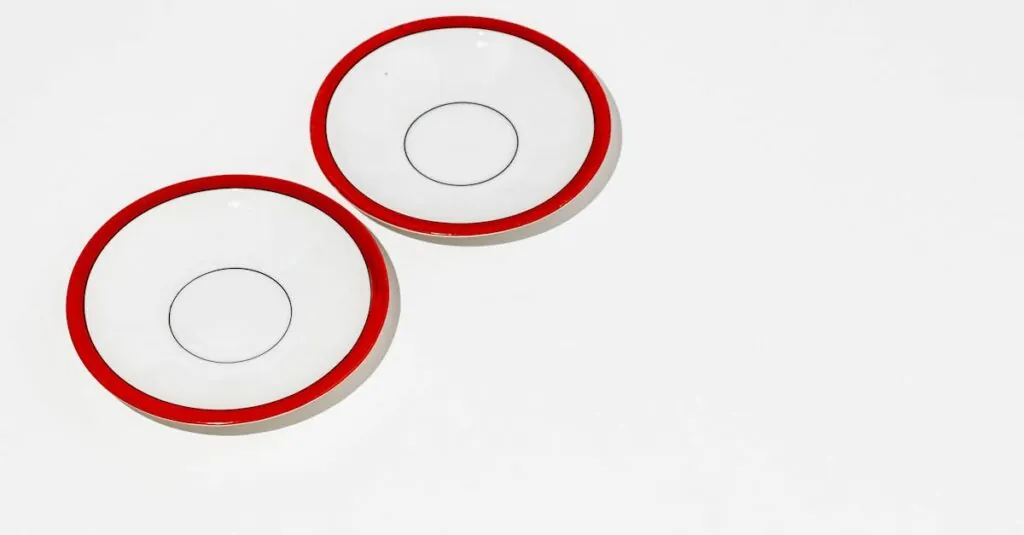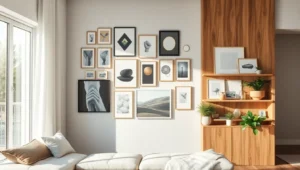Living in a small space doesn’t mean sacrificing style. In fact, it’s the perfect opportunity to unleash creativity and transform those cozy nooks into stunning retreats. Whether it’s a tiny apartment or a compact studio, every square foot can shine with the right decorating tricks.
Table of Contents
ToggleUnderstanding Small Space Decor
Small spaces can inspire innovative design ideas. Utilizing effective decor techniques maximizes the potential of apartments and studios alike.
Importance of Space Optimization
Space optimization plays a vital role in small room functionality. Every corner can serve a purpose, leading to increased efficiency. Smart furniture choices, like multi-functional pieces, allow for both style and utility. Using vertical storage solutions also enhances organization while visually expanding the area. A cohesive color palette can establish a sense of harmony, making the environment feel more open. Natural light should be embraced, as it creates an airy atmosphere, encouraging a feeling of spaciousness.
Common Challenges in Small Spaces
Common challenges in small spaces include limited square footage and furniture arrangements. Often, finding enough storage becomes a daunting task. Tight layouts can lead to clutter, which negatively impacts the aesthetic appeal. Small areas may lack natural light, making them feel confined. Furnishing compact areas demands creativity and thoughtful planning. Another issue is maintaining functionality while ensuring comfort. Decor elements must be carefully chosen to avoid overwhelming the space with unnecessary items.
Essential Small Space Decorating Tips
Small spaces offer unique opportunities for creativity in decor. Designing a small area requires thoughtful choices that emphasize functionality and aesthetics.
Color Schemes for Small Spaces
Colors significantly impact how a space feels. Light hues, such as whites and pastels, create an illusion of openness. Dark colors can make a room feel cozier but may shrink the appearance. Use monochromatic palettes to unify patterns and elements. Accent walls can highlight focal points without overwhelming the room. Additionally, incorporating mirrors enhances light and gives depth, making the space feel larger.
Choosing the Right Furniture
Selecting appropriate furniture is crucial in small spaces. Multi-functional pieces, such as ottomans with storage or fold-out desks, serve dual purposes while saving room. Prioritize scale; smaller furniture prevents overwhelming the space. Transparent materials, like acrylic chairs, maintain an open feel by blending with surroundings. Avoid bulky furniture that hinders flow and accessibility. Arrange items to foster easy movement, enhancing usability and comfort.
Utilizing Vertical Space
Maximizing vertical space offers creative storage solutions. Shelving units can take advantage of walls while preserving floor space. Wall-mounted racks or hooks allow for practical storage of items like bikes or tools. Vertical gardens create greenery without occupying ground area, enhancing aesthetics. Consider tall bookcases that draw the eye upward, creating an illusion of height. Place decorative items on higher shelves to keep surfaces tidy and maintain visual interest.
Creative Storage Solutions
Maximizing space in a small area requires innovative storage approaches. Smart solutions can transform clutter into organized, functional living.
Multi-Purpose Furniture
Selecting multi-purpose furniture serves as a game changer in small spaces. Sofas that convert into beds or ottomans with hidden storage enhance functionality. For example, dining tables that collapse or expand can accommodate various needs. Consider using bookshelves that double as room dividers; this practice maintains an open flow while optimizing storage. Choosing pieces that blend seamlessly with the decor can improve both aesthetics and usability. Multi-functional furniture promotes a clutter-free environment, which is essential for compact living.
Under-Utilized Areas
Identifying under-utilized areas can unlock hidden storage potential. Corners, underneath beds, and vertical wall spaces often go unnoticed. Utilizing tall shelving units in these areas creates additional storage while drawing the eye upward. Hooks and pegboards can transform empty wall sections into creative storage solutions. Beneath sinks and staircases also provide excellent opportunities for built-in storage. Emphasizing these overlooked spaces encourages a more organized and spacious atmosphere.
Personalizing Your Small Space
Personalizing a small space creates a unique and inviting atmosphere. Thoughtful details add character and express individual style.
Incorporating Art and Accessories
Art and accessories bring life to any compact area. Consider mixing various art forms, such as paintings, photographs, and prints, to create visual interest. Create a gallery wall with framed pieces to draw attention while maximizing vertical space. Incorporate decorative items like vases, books, and candles on shelves and tables, enhancing personality through texture and color. Select accessories that reflect personal interests or hobbies; these elements tell a story and foster a connection to the environment. Utilizing a few statement pieces rather than numerous smaller items can avoid visual clutter.
Creating a Cozy Ambiance
Creating a cozy ambiance fosters warmth in small spaces. Use soft lighting, such as string lights or table lamps, to add warmth and create intimacy. Incorporate textiles, including throw pillows and blankets, which add comfort and warmth without overwhelming the space. Choose rugs in soft colors and textures to define areas and enhance comfort underfoot. Emphasizing natural materials like wood and woven fibers instills a welcoming, organic feel. Finally, plants enhance air quality while adding a touch of nature; opt for smaller varieties that fit well in compact areas.
Conclusion
Transforming a small space into a stylish and functional haven is entirely achievable with the right approach. By embracing creativity and making smart design choices, anyone can maximize their living area while reflecting their personal style. Utilizing multi-functional furniture and innovative storage solutions can significantly enhance both usability and aesthetics.
Incorporating a thoughtful color palette and personal touches through art and textiles adds warmth and character. With careful planning and a focus on optimizing every inch, small spaces can feel open and inviting. Ultimately, it’s about making the most of what’s available and creating a home that truly feels like a retreat.





